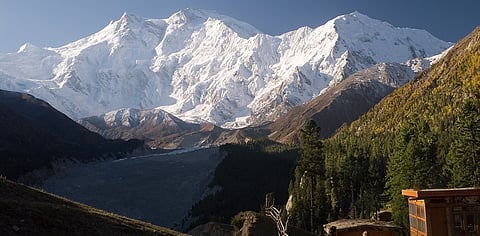

Many mountain and downstream communities could suffer extreme losses exceeding adaptation limits if the current rise of carbon dioxide continues, leading to a warming of at least 3°C by 2100.
With rapid warming, glacier and snow loss, vulnerable mountain and downstream communities could face non-survivable conditions by 2050 due to loss of seasonal water availability, or destructive floods, reads the State of the Cryosphere 2024 report released at the 29th Conference of Parties to the United Nations Framework Convention on Climate Change in Baku.
If the world crosses the 3°C mark, ice loss from Greenland and especially from West Antarctica becomes extremely rapid.
“Without urgent climate action, it will be impossible for coastal cities and regions to adapt in time,” James Kirkham, Chief Scientist to AMI and an author on the Report, said in a statement.
“We are not talking about the distant future: the impacts of cryosphere loss are already felt by millions. But the speed of action we take today decides the size and speed of the challenge to which future generations will need to adapt. The impacts of cryosphere loss will only become greater with every hour that leaders delay action now,” he added.
The cryosphere [includes snow cover, glaciers, ice sheets, ice shelves, icebergs, sea ice, lake ice, river ice, permafrost, and seasonally frozen ground, and solid precipitation] must be put at the top of the global climate agenda, he added.
At high temperatures, the Arctic Ocean will be ice-free for nearly 180 days each year. This could enhance Arctic warming. As the bright and reflective ice melts, it exposes the darker ocean, which absorbs more heat from the Sun than snow and ice.
The report further adds that surpassing the 1.5°C goal of the Paris Agreement is extremely risky due to the cryosphere’s response.
The longer temperatures exceed the 1.5°C threshold, the higher the peak temperature, the greater the risk of crossing tipping points for ice sheets in a number of places. These include the Arctic and Antarctic, many land glaciers, and the Atlantic Meridional Overturning Circulation (AMOC), a system of ocean currents that circulates water within the Atlantic Ocean, bringing warm water north and cold water south.
The Intergovernmental Panel on Climate Change defines tipping points as ‘critical thresholds’, when exceeded, can lead to a significant change, often with an understanding that the change is irreversible.
On the other hand, the impacts on permafrost (permanently frozen grounds) are different. Permafrost melting increases with every fraction of warming, with no sudden “tipping point”, the report warned.
Permafrost melting releases carbon dioxide, methane, and nitrous oxide. The Arctic-boreal permafrost region is now emitting greenhouse gas warming, according to the report.
Similarly, ocean acidification in polar waters has no discrete tipping point. The effects could last for thousands of years, causing observed damage to shelled organisms, it added.
Another concern is the rate of global sea-level rise, which has already doubled in the last 30 years. “If these trends continue, rates would increase to 6.5 mm per year by 2050, approaching limits of feasible adaptation,” the report stated.
The year 2024 has seen records being broken due to extremely low snowfall combined with extremely high summer temperatures. The Hindu Kush Himalaya saw record-low snowfall, causing growing concern for water supplies in South Asia.
In 2024, Venezuela lost its final glacier, Humboldt, joining Slovenia as the first two countries to lose their glaciers in modern times. Indonesia’s Puncak Jaya (also called “Eternity Glacier”) will likely see the same fate in next two years.
“Policymakers cannot afford to ignore the spreading global damage from a warming cryosphere. It has been downplayed in the UN climate negotiations for far too long. We can change this at COP29. With the knowledge that each additional fraction of a degree of warming increases the risks and costs to all nations, now is the time to act. To save the cryosphere is to save ourselves,” Pam Pearson, Director of International Cryosphere Climate Initiative, a network of senior policy experts and researchers aiming to spread cryosphere science and preserve the cryosphere’s key role in Earth’s climate system, noted.